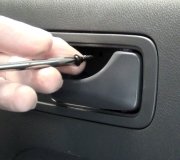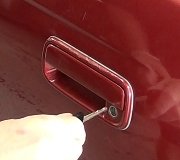There are two wires going to the motor. For the tests to be accurate for this type of problem, use a test light instead of a digital voltmeter, if possible, and do the tests with the wires connected to the motor, again, if possible. If you can imagine looking at the huge volume of water behind the Hoover Dam, and how much electricity you could generate with that, you have to have a really huge pipe for that water to flow through. If you only have a hole half the diameter of a pencil, you can't do much work with that. The same thing applies to this type of circuit problem. All you need is one tiny strand of copper wire still intact to get a good solid twelve volt reading, but you would never get enough current through that to run a window motor. The voltmeter does not draw any current to do its thing, so the circuit will look good with just that one remaining strand of wire. A test light needs current to work, and the motor needs lots of current to run. If that current cannot get through an arced switch contact or a frayed wire to run the motor, that will quickly show up with a test light.
Connect the test light to the motor's two wires. It should be nice and bright when you press the switch either way. If it is not, you can figure out which of those wires has the problem by moving the test light's ground clip to a paint-free point on the body, and leaving the probe on one of the motor's wires. Press the switch one way, then the other way. One way you should get zero volts and the other way you should get twelve volts. If you get zero volts, then, ... Oh, ... Say, eight volts, that circuit has the problem.
Do the same test on the other wire. If you get twelve volts when pressing the switch one way, and something, but much less the other way, it is the other circuit that has the problem. The twelve volts is being split between the motor and the bad connection in the other circuit. To say that a different way, the bad circuit is not providing a solid ground circuit.
I am sorry that I am not explaining that very well. It is much easier to do with a diagram on the blackboard that I can point to. I purposely overlooked testing before the switch, meaning looking for frayed wires between the door hinges, because the other windows work properly. Current for them all goes through the driver's switch assembly and the same twelve volt and ground wires in the driver's door used by the driver's window, so all of that must be okay.
Based on what you find, we might be able to determine right away what is wrong, otherwise I will dig up a wiring diagram and we can look at the wires at the switch.
Saturday, June 9th, 2018 AT 10:59 PM


